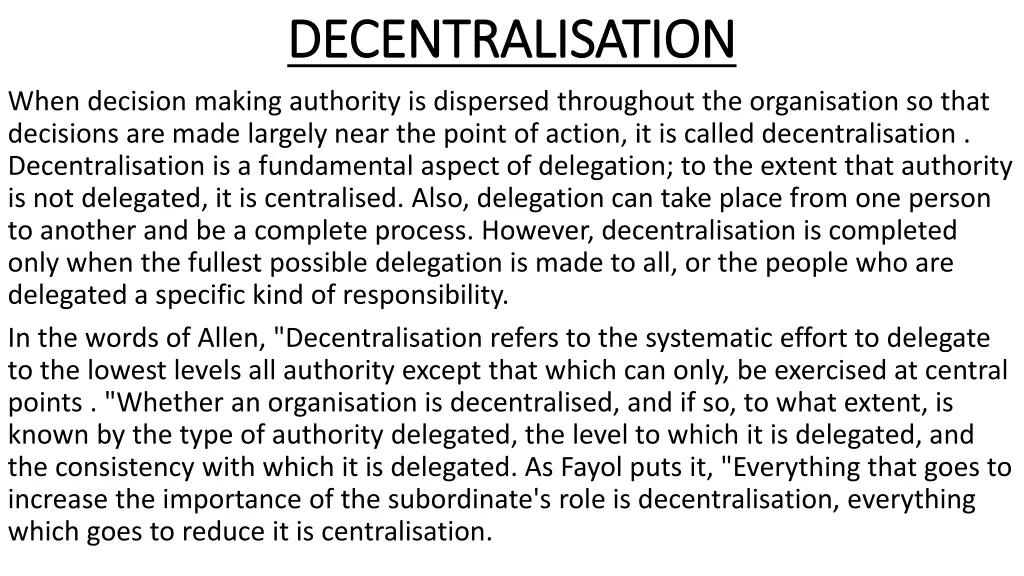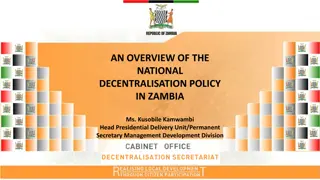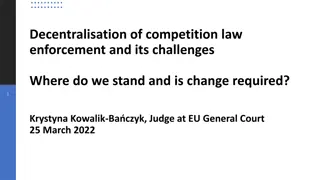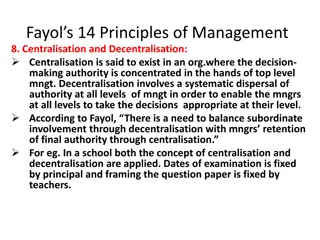
Understanding Decentralisation in Organisational Decision-Making
Decentralisation in organisations involves dispersing decision-making authority to lower levels, allowing for quick decisions, effective control, and enhanced motivation. Explore its advantages, such as reducing the burden on top executives and fostering executive development, along with limitations like coordination challenges and increased expenses.
Download Presentation

Please find below an Image/Link to download the presentation.
The content on the website is provided AS IS for your information and personal use only. It may not be sold, licensed, or shared on other websites without obtaining consent from the author. If you encounter any issues during the download, it is possible that the publisher has removed the file from their server.
You are allowed to download the files provided on this website for personal or commercial use, subject to the condition that they are used lawfully. All files are the property of their respective owners.
The content on the website is provided AS IS for your information and personal use only. It may not be sold, licensed, or shared on other websites without obtaining consent from the author.
E N D
Presentation Transcript
DECENTRALISATION DECENTRALISATION When decision making authority is dispersed throughout the organisation so that decisions are made largely near the point of action, it is called decentralisation . Decentralisation is a fundamental aspect of delegation; to the extent that authority is not delegated, it is centralised. Also, delegation can take place from one person to another and be a complete process. However, decentralisation is completed only when the fullest possible delegation is made to all, or the people who are delegated a specific kind of responsibility. In the words of Allen, "Decentralisation refers to the systematic effort to delegate to the lowest levels all authority except that which can only, be exercised at central points . "Whether an organisation is decentralised, and if so, to what extent, is known by the type of authority delegated, the level to which it is delegated, and the consistency with which it is delegated. As Fayol puts it, "Everything that goes to increase the importance of the subordinate's role is decentralisation, everything which goes to reduce it is centralisation.
Advantages of Decentralisation. Advantages of Decentralisation. The following are the advantages of decentralisation: (1) Reduction in the burden of chief executive. Unlike centralisation, in decentralisation subordinates share the burden of decision making and operating details, thereby enabling the top executives to concentrate on more important problems of policy making and overall control. (2) Possibilities of growth and diversification. In a decentralised enterprise, size- growth and diversification-is not limited by the number of executives. There is continuous supply of executives to man new departments and divisions created as a result of growth and diversification of operations. (3) Executive development. When authority is decentralised, lower level executives get opportunity of taking initiative, and exercising authority, and develop their own managerial qualities.
(4) Improvement of motivation and morale. Since local executives are given greater opportunities of communication and leadership, they can foster team spirit and group cohesion among the subordinates. The subordinates feel highly motivated and their morale is also high. (5) Quick decisions. Since decision making power in a decentralised organisation 1 rests as near as possible to the place where action takes place, red tapism is avoided and decisions are taken quickly. (6) Effective control. In a decentralised organisation the span of control becomes very effective because the managers at lower levels are given a fair degree of autonomy and decision making power, e.g., they have the authority to change work assignments and production schedules, and to recommend promotions, disciplinary actions, etc. (7) Greater flexibility. Decentralisation results into the creation of small semi- autonomous divisions and departments which are placed under the charge of individual executives. These executives are given authority to effect necessary changes without dislocating the entire organisation structure.
Limitations of Decentralisation. Limitations of Decentralisation. (1) Difficulty in co-ordination. Since in a decentralised organisation authority is widely dispersed throughout the organisation, there may be lack of uniformity and consistency of action, thereby making co-ordination a difficult task. (2) Higher expenses. Decentralisation requires trained personnel at various levels to accept and exercise authority. This increases administrative expenses of the organisation. (3) Unsuitable for small concerns. Decentralisation implies creation of autonomous units which requires broad product lines. This is, however, not possible in the case of small units. (4) External constraints. Decentralisation may not be feasible due to external constraints and uncertainties, both of which can be dealt with properly under a centralised set-up. (5) Inappropriate in emergencies. Decentralisation becomes a handicap in case quick emergent decisions have to be made
As an aspect of management, the terms centralisation and decentralisation refer to with holding or delegating authority and authority concentration or dispersal in decision making . It is to be noted that absolute centralisation or absolute decentralisation is neither possible nor desirable because in the former case there will be no subordinate managers, and in the latter case, since managers should delegate all their authority, their status as managers will cease and therefore, there will be no structured organisation in either case. Centralisation and decentralisation are therefore tendencies; they are qualities like "hot" and "cold






